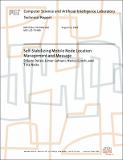Self-Stabilizing Mobile Node Location Management and Message
Author(s)
Dolev, Shlomi; Lahiani, Limor; Lynch, Nancy; Nolte, Tina
DownloadMIT-CSAIL-TR-2005-052.ps (26.50Mb)
Additional downloads
Other Contributors
Theory of Distributed Systems
Metadata
Show full item recordAbstract
We present simple algorithms for achieving self-stabilizing locationmanagement and routing in mobile ad-hoc networks. While mobile clients maybe susceptible to corruption and stopping failures, mobile networks areoften deployed with a reliable GPS oracle, supplying frequent updates ofaccurate real time and location information to mobile nodes. Informationfrom a GPS oracle provides an external, shared source of consistency formobile nodes, allowing them to label and timestamp messages, and henceaiding in identification of, and eventual recovery from, corruption andfailures. Our algorithms use a GPS oracle.Our algorithms also take advantage of the Virtual Stationary Automataprogramming abstraction, consisting of mobile clients, virtual timedmachines called virtual stationary automata (VSAs), and a local broadcastservice connecting VSAs and mobile clients. VSAs are distributed at knownlocations over the plane, and emulated in a self-stabilizing manner by themobile nodes in the system. They serve as fault-tolerant building blocksthat can interact with mobile clients and each other, and can simplifyimplementations of services in mobile networks.We implement three self-stabilizing, fault-tolerant services, each builton the prior services: (1) VSA-to-VSA geographic routing, (2) mobileclient location management, and (3) mobile client end-to-end routing. Weuse a greedy version of the classical depth-first search algorithm toroute messages between VSAs in different regions. The mobile clientlocation management service is based on home locations: Each clientidentifier hashes to a set of home locations, regions whose VSAs areperiodically updated with the client\'s location. VSAs maintain thisinformation and answer queries for client locations. Finally, theVSA-to-VSA routing and location management services are used to implementmobile client end-to-end routing.
Date issued
2005-08-11Other identifiers
MIT-CSAIL-TR-2005-052
MIT-LCS-TR-999
Series/Report no.
Massachusetts Institute of Technology Computer Science and Artificial Intelligence Laboratory